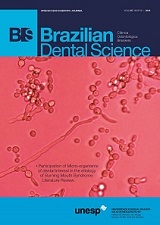Effectiveness of low level laser therapy in the treatment of TMD myalgia - Two case reports
DOI:
https://doi.org/10.14295/bds.2013.v16i2.867Abstract
Objective: To report two cases of low level laser therapy used in the treatment of muscle pain caused by temporomandibular disorders (TMDs). Methods: Two patients of the São José dos Campos Dental School (UNESP) were selected and subjected to eight applications of low level laser therapy (diode). Laser was punctually applied on masseter and temporalis muscles bilaterally. Three methods were used to evaluate the effectiveness of treatment: pressure algometer, visual analog scale (VAS) and maximal mouth opening. Each measure was performed before and after the laser therapy session. The results were subjected to statistical analysis (ANOVA two factors and Tukey's test, ? = 0.05). Results: For both patients, no significant difference was found between the results obtained by algometer before and after laser application within each session. Nonetheless, VAS showed a tendency to lower values after laser application. The highest values obtained by the pressure algometer were found between days 9 (fourth application) and 16 (sixth application), in both cases. Both patients had an improvement in mouth opening. Conclusions: The assessment methods used were quite practical to register the pain before and after treatment. Therapy with low level laser seems to have a beneficial effect for muscle pain of temporomandibular joint (TMJ).
Downloads
Downloads
Additional Files
Published
How to Cite
Issue
Section
License
Brazilian Dental Science uses the Creative Commons (CC-BY 4.0) license, thus preserving the integrity of articles in an open access environment. The journal allows the author to retain publishing rights without restrictions.
=================




























